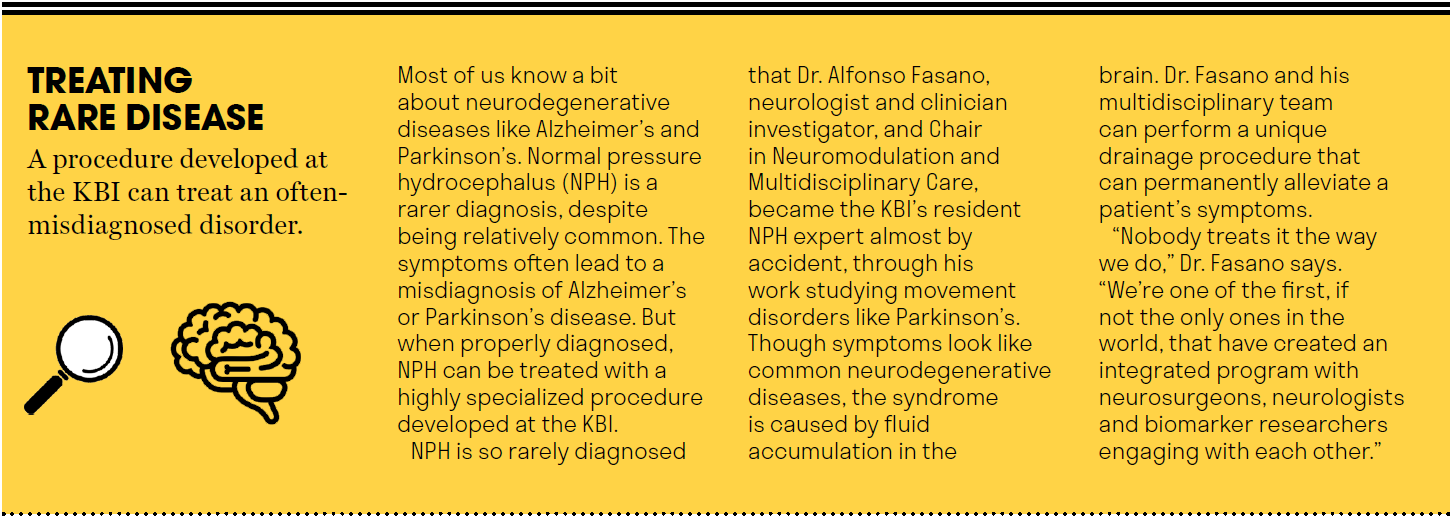[L-R] Dr. Andres Lozano, Dr. Carmela Tartaglia, Dr. Gabor G. Kovacs, Dr. Milad Lankarany and Dr. Olga Rojas. (Photo: Regina Garcia)
By Elizabeth Chorney-Booth
There are few medical diagnoses more terrifying than diseases that affect the brain. Whether it’s Parkinson’s disease, Alzheimer’s or another form of dementia, or the long-term effects of concussion, neurodegenerative diseases directly impact how we identify as human beings. Everyone dreads the thought of losing brain function and, especially, their memories. Worst of all, there is no known cure or effective treatment for most of these disorders.
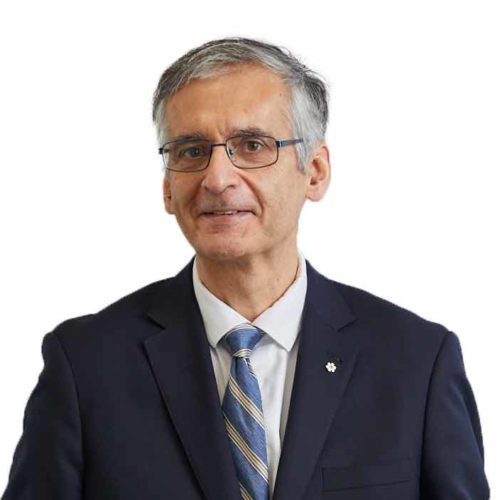
– Dr. Andres Lozano
At the Krembil Brain Institute (KBI), some of the world’s top medical minds have dedicated their careers to cracking neurodegeneration’s still-elusive code. They’re working on innovative ways to diagnose disease earlier, experimenting with novel treatments like electrical stimulation, employing advanced computational science to study the impact of surgery on the brain and more.
No one is looking for band-aid solutions. Instead, they want to develop a comprehensive understanding of neurodegenerative diseases and how they can be prevented, treated and eventually cured. “We’re not going for the low-hanging fruit. We’re going for the apple at the top of the tree,” says Dr. Donald Weaver, Research Director of the KBI. “We’re going to have to step on some branches we haven’t trodden upon before.”

– Dr. Gabor G. Kovacs
Better diagnoses
One challenge is that different neurodegenerative diseases have similar symptoms: if a patient complains about forgetfulness or motor control problems, diagnosis is difficult until symptoms progress. Since many researchers believe early diagnosis can give clinicians a better chance of treating disorders like Parkinson’s and Alzheimer’s, as well as the fallout of repeated concussions, developing new diagnostic methods is a potential game-changer.
Dr. Carmela Tartaglia, a neurologist and clinician investigator at the KBI who studies both concussion and neurodegenerative issues, wants to detect cognitive impairment problems earlier, while also using biomarkers to generate more precise and individualized diagnoses. One challenge with that is concussions and other brain-related diseases can’t be properly diagnosed until after death. “What we’re striving to do is to bring precision medicine, the kind we have come to accept with cancer and heart disease, to neurodegenerative diseases,” says Dr. Tartaglia, who is also the Marion and Gerald Soloway Chair in Brain Injury and Concussion Research. “We want to talk to patients about the cause of their dementia and give them a specific diagnosis, because different kinds of dementia have very different prognoses.”
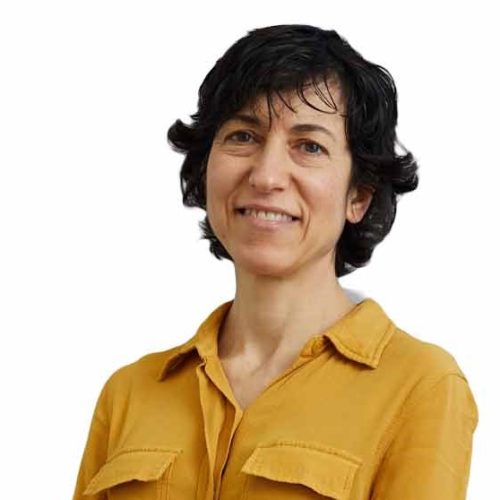
– Dr. Carmela Tartaglia
Surgical successes
There may be no cure for most neurodegenerative diseases, but the KBI is working on developing life-altering treatments that can help with symptoms, particularly for Parkinson’s disease. Dr. Andres Lozano, a neurosurgeon and senior scientist at the KBI, and the R. R. Tasker Chair in Stereotactic and Functional Neurosurgery, is a pioneer in the use of deep brain stimulation (DBS), which can dramatically ease the symptoms of a number of neurological disorders, including Parkinson’s and Huntington’s diseases. A recent study showed an 88 per cent accuracy in optimizing DBS stimulation settings, through combining fMRI results, which show metabolic activity in the brain, with machine learning techniques. “The hope is that this could facilitate more customized treatments for our patients,” says Dr. Lozano, who is also part of the Sprott Department of Surgery at University Health Network.
50 million
Source: Alzheimer’s Disease International
People who have dementia globally as of 2020.
While DBS, which uses electrodes to stimulate nerves within the brain, is a well-established treatment for Parkinson’s, Dr. Lozano is leading a significant third-phase study examining its potential for managing Alzheimer’s disease. “This is a very different approach to treating Alzheimer’s,” he says. “Most Alzheimer’s research involves trying different drugs. This is something different, where we’re changing the activity of the brain using electricity.”

The brain, from every angle
When a breakthrough happens, it’s going to be because of the KBI’s multidisciplinary and highly innovative approach to research.
For instance, Dr. Gabor G. Kovacs, a neuropathologist and senior scientist at the KBI, works with the donated brain tissue of deceased patients. This allows clinicians to see first-hand how Alzheimer’s, Parkinson’s and a wide spectrum of neurodegenerative diseases affect the human brain at the microscopic and molecular level. Dr. Tartaglia can tell how her biomarker research correlates to what is observed in the brain, while Dr. Lozano can examine how electrical stimulation affects brain tissue. There’s also important work being done in the Edmond J. Safra Program in Parkinson’s Disease, led by Dr. Anthony Lang, the Lily Safra Chair in Movement Disorders.
10 million+ Estimated number of people living with Parkinson’s disease worldwide.
Source: Parkinson’s Foundation
Dr. Kovacs believes the communication and complementary research between clinical and lab-based scientists are some of the keys to the KBI’s success. “Neurodegenerative diseases really need to be approached with this harmonized team strategy,” he says.
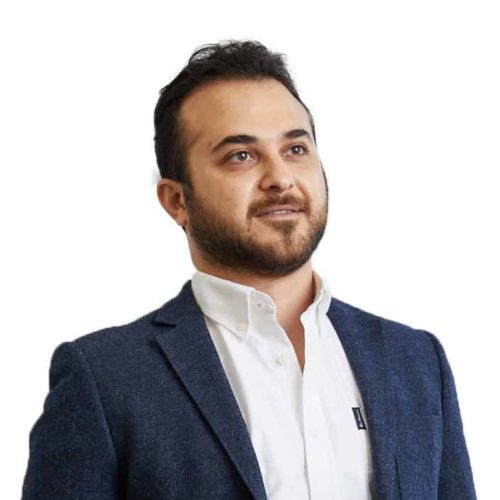
– Dr. Milad Lankarany
Connecting the body with the mind
This is why the KBI has recruited leading neurologists, neurosurgeons and specialists to the team, each of whom brings a unique perspective to brain research. Dr. Olga Rojas, an immunologist and scientist, for example, is a recent addition to the team whose background is the gut microbiome.
Dr. Rojas studies the relationship between inflammation and neurodegeneration, particularly how our bodies’ responses to bacteria and other factors that cause inflammation might contribute to Alzheimer’s and Parkinson’s diseases. It’s a growing area of study that may help researchers connect disorders of the brain with other issues in a patient’s body. The assertion isn’t that inflammation is the sole cause of neurodegenerative disease, but that it’s one part of a larger puzzle. “We’ve shown a link between the immune cells that develop in the intestine, from bacteria that grow in the gut, and inflammation in the brain,” she says. “We’ve been able to learn how this affects the progression of diseases like multiple sclerosis, and now I’m trying to translate that knowledge to see if it applies to neurodegeneration.”
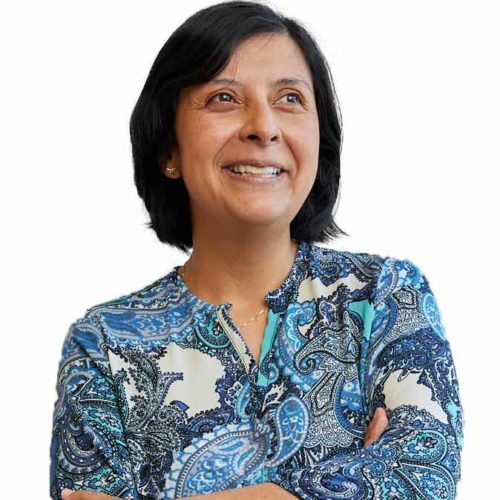
– Dr. Olga Rojas
Cutting-edge approaches
Basic science and clinical research are key tools in the fight against neurodegenerative diseases, but the KBI also takes some less conventional approaches to supplement more traditional methods. The KBI is a leader in computational neuroscience, a field that uses mathematical tools to better understand brain function.
Experts like Dr. Milad Lankarany, a scientist at the KBI, use computational neuroscience to help researchers like Dr. Lozano gain a better picture of how his surgery methods affect brain function. “We use data that clinicians and neurosurgeons have recorded from their patients to develop models that can show us how a neurodegenerative brain works differently,” Dr. Lankarany says.
Meanwhile, Dr. Maurizio De Pittà, also a scientist at the KBI, is using computational neuroscience to study neuron-glia interactions, particularly in relation to Alzheimer’s disease. “My models aim to diagnose pathological scenarios and guide therapeutic interventions,” Dr. De Pittà explains.
All of the KBI’s research projects and methods overlap and intersect to form a bigger picture of how these diseases affect the brain and how they might be treated, leading to many significant behind-the-scenes breakthroughs. While we’re more likely to see a series of treatments than a miracle cure, real advancements are around the corner as long as scientists continue to get the support and funding they need to do this monumental work.
“People must understand that this is doable,” Dr. Tartaglia says. “Look at cancer. If cancer research had stopped because they didn’t yet have cures, we wouldn’t have any of the life-saving treatments we do today. We need to make that same investment in brain disease research that’s led to so many cancer breakthroughs. We’ve already come a long way, but with the right resources in place, we’ll be making real headway.”
